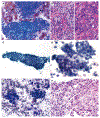Fine needle aspiration of salivary gland carcinomas with high-grade transformation: A multi-institutional study of 22 cases and review of the literature
- PMID: 33211402
- PMCID: PMC9361188
- DOI: 10.1002/cncy.22388
Fine needle aspiration of salivary gland carcinomas with high-grade transformation: A multi-institutional study of 22 cases and review of the literature
Abstract
Background: High-grade transformation (HGT) is a rare process whereby conventional low- to intermediate-grade salivary gland carcinomas (SGC) transform into high-grade, poorly or undifferentiated malignancies with focal or complete loss of their conventional histomorphologic features. Because tumors with HGT are associated with a worse prognosis than their conventional counterparts, preoperative recognition of HGT may be of benefit for optimal patient management. Using a multi-institutional approach, we describe the largest fine needle aspiration (FNA) cohort of salivary gland carcinomas with HGT.
Methods: The archives of 9 large academic medical centers were searched, and 22 cases of SGC with HGT were identified by surgical excision accompanied by preoperative FNA. Clinical and cytomorphologic features were retrospectively reviewed.
Results: The male-to-female ratio was 14:8, and the mean patient age was 60.2 years. The average tumor size was 3.6 cm, and 19 cases were from the parotid gland. Acinic cell carcinoma with HGT was the most common tumor subtype, comprising 12 cases with HGT, followed by adenoid cystic carcinoma, secretory carcinoma, and other subtypes. Eighteen cases were classified as malignant; however, a specific diagnosis of HGT was not made. Sixteen cases contained a high-grade cytologic component, and 7 cases had a mixture of both conventional and high-grade components retrospectively.
Conclusions: SGC with HGT should be considered in the differential diagnosis of a salivary gland aspirate exhibiting high-grade cytomorphologic features. The presence of distinct tumor populations, conventional and high-grade, should prompt consideration of HGT, especially when the conventional component is acinic cell carcinoma or adenoid cystic carcinoma.
Keywords: acinic cell carcinoma; adenoid cystic carcinoma; fine needle aspiration; high-grade transformation; salivary cytology; salivary gland; salivary gland carcinoma; secretory carcinoma.
© 2020 American Cancer Society.
Conflict of interest statement
CONFLICT OF INTEREST DISCLOSURES
The authors made no disclosures.
Figures


Similar articles
-
Cytologic grading of primary malignant salivary gland tumors: A blinded review by an international panel.Cancer Cytopathol. 2020 Jun;128(6):392-402. doi: 10.1002/cncy.22271. Epub 2020 Apr 8. Cancer Cytopathol. 2020. PMID: 32267606 Free PMC article.
-
Mucoepidermoid carcinoma, acinic cell carcinoma, and adenoid cystic carcinoma on fine-needle aspiration biopsy and The Milan System: an international multi-institutional study.J Am Soc Cytopathol. 2019 Sep-Oct;8(5):270-277. doi: 10.1016/j.jasc.2019.04.001. Epub 2019 Apr 9. J Am Soc Cytopathol. 2019. PMID: 31104944
-
Cytopathology of acinic cell carcinoma: A study of 50 cases, including 9 with high-grade transformation.Cancer Cytopathol. 2021 Dec;129(12):973-983. doi: 10.1002/cncy.22496. Epub 2021 Aug 11. Cancer Cytopathol. 2021. PMID: 34379894
-
High-grade Transformation/Dedifferentiation in Salivary Gland Carcinomas: Occurrence Across Subtypes and Clinical Significance.Adv Anat Pathol. 2021 May 1;28(3):107-118. doi: 10.1097/PAP.0000000000000298. Adv Anat Pathol. 2021. PMID: 33825717 Review.
-
Pitfalls in Salivary Gland Cytology.Acta Cytol. 2024;68(3):194-205. doi: 10.1159/000538069. Epub 2024 Feb 28. Acta Cytol. 2024. PMID: 38417405 Review.
Cited by
-
Minimally invasive biopsy-based diagnostics in support of precision cancer medicine.Mol Oncol. 2024 Nov;18(11):2612-2628. doi: 10.1002/1878-0261.13640. Epub 2024 Mar 22. Mol Oncol. 2024. PMID: 38519839 Free PMC article. Review.
-
Clinicopathologic characterization of secretory carcinoma of salivary gland.World J Surg Oncol. 2024 Oct 25;22(1):282. doi: 10.1186/s12957-024-03561-9. World J Surg Oncol. 2024. PMID: 39456022 Free PMC article.
-
Bioinformatics identification of the candidate microRNAs and construction of a competing endogenous RNA regulatory network in lacrimal gland adenoid cystic carcinoma high-grade transformation.Oncol Lett. 2021 May;21(5):360. doi: 10.3892/ol.2021.12621. Epub 2021 Mar 8. Oncol Lett. 2021. PMID: 33747217 Free PMC article.
-
Parotid Gland Tumors: Molecular Diagnostic Approaches.Int J Mol Sci. 2024 Jul 4;25(13):7350. doi: 10.3390/ijms25137350. Int J Mol Sci. 2024. PMID: 39000457 Free PMC article. Review.
-
Value of cytopathology in the diagnosis of adenoid cystic carcinoma and an analysis of misdiagnoses.BMC Surg. 2023 Mar 9;23(1):52. doi: 10.1186/s12893-023-01945-4. BMC Surg. 2023. PMID: 36894958 Free PMC article.
References
-
- El-Naggar AK. WHO Classification of Head and Neck Tumours. International Agency for Research on Cancer; 2017.
-
- Faquin WC, Rossi ED, Baloch Z, et al. The Milan System for Reporting Salivary Gland Cytopathology. Springer; 2018.
-
- Nakaguro M, Faquin WC, Sadow PM. Cytologic and histologic aspects of high-grade transformation of salivary gland carcinoma. AJSP Rev Rep. 2020;25:243–248.

